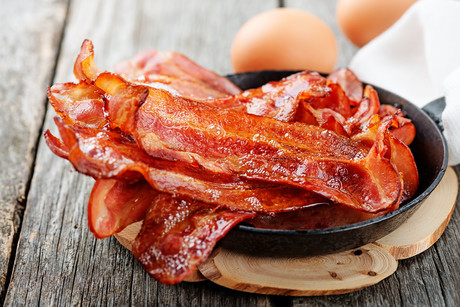Let's eat pork — but only if the pigs are healthy

Pork consumption has risen 25% in Australia since 2010 and now the fight is on to ensure the Australian pig population is healthy and pork fit for consumption.
African Swine Fever
The Department of Agriculture and Water Resources has increased its controls and remains committed to keeping Australia’s $60 billion agricultural industries free from the diseases such as African swine fever (ASF).
To this end the department has increased its border activities. Samples of pork products have been seized at international airports and mail processing centres and tested at the Australian Animal Health Laboratory in Geelong.
Six of the 152 pork samples tested over a two-week period were contaminated with ASF virus.
The department is pointing out that while these positive tests do not change Australia’s ASF-free status, compliance with Australia’s strict biosecurity requirements is absolutely essential.
The department’s Head of Biosecurity, Lyn O’Connell, explained: “African swine fever is not present in Australia. If introduced it would have a significant impact on pig health and production, and contribute to wider economic impacts caused by a loss of access to overseas markets for our pork products.
“Humans are not susceptible to ASF but we all have a role in preventing it, and other exotic animal diseases from arriving in Australia — even if we don’t own or work around farm animals.
“It is crucial that all participants in Australia’s biosecurity system play their part in managing this threat.
“People visiting or returning to Australia from countries where this disease is present need to pay particular attention to biosecurity requirements and not bring banned product with them. If travellers are carrying foods, plant material or animal products in their luggage they must declare them on their incoming passenger card.
“Before making online purchases, check what can and cannot be mailed to Australia. Pork products cannot be brought into Australia except under specific import conditions.
“If you are unsure of an item, declare it, or don’t bring it at all.”
More information about ASF and biosecurity requirements for incoming passengers and for people who are purchasing goods from overseas can be found at: www.agriculture.gov.au/pests-diseases-weeds/animal/asf.
Listeria in the feed: a dangerous hygiene problem in fattening pigs
In a recent study, researchers from Vetmeduni Vienna investigated an episode of fatal listeriosis in fattening pigs with a mortality rate of nearly 10%. The research team traced the source of infection to the fed silage. Following simple guidelines during the ensilaging process can minimise this risk — with benefits for food safety and public health.
The present case investigated at Vetmeduni Vienna is the first clinical report on this form of listeriosis in fattening pigs. In their study, researchers from the Institute of Microbiology, the Institute of Pathology and the Institute of Milk Hygiene, under coordination by Lukas Schwartz from the University Clinic for Swine, showed that the bacterium Listeria monocytogenes, as the causative agent of listeriosis, should — contrary to current practice — form part of the list of differential diagnoses when fattening pigs suffer from bloody diarrhoea and septicaemia.
The study was motivated by an episode of fatal listeriosis in fattening pigs in a pig farm in Lower Austria with an integrated fattening unit with space for 450 pigs. Clinical symptoms such as anorexia, bloody diarrhoea and an increased body temperature up to 40°C were observed in about 10% of the fattening pigs, mostly in well-fed animals with a body weight of 40–100 kg. In total, 35 fattening pigs died in a period of about 3 weeks.
Two fattening pigs with clinical symptoms as well as fed maize silage samples were investigated for further diagnostics. Molecular biological characterisation isolated identical L. monocytogenes strains from samples taken from the pigs and in the maize silage. Additionally, a high content of deoxynivalenol was found in the maize silage. Deoxynivalenol is a mycotoxin found above all as a metabolic product in affected grains with potentially negative effects for the immune system. “The feeding of maize silage contaminated by Listeria, which survive under poor ensilaging conditions, was the most likely source of infection of the fattening pigs,” said first author Heiko Stein.
Ensilaging under anaerobic conditions provides reliable protection
The researchers were able to show with their study that L. monocytogenes can cause clinical disease in fattening pigs that may be the result of immunosuppression due to high deoxynivalenol exposure. Stein therefore formulates the following appeal: “When feeding silage, it is important that all ensilaging procedures occur under appropriate anaerobic conditions to guarantee suppression of listerial growth.”
Six beverage trends predicted for 2026
Demand for customisation, 'protein-ification' and sustainable storytelling are some of...
Making UHT processing less intensive on energy
A nutritional beverages company was seeking a more sustainable way to produce UHT beverages using...
Tasty twist for chocolate alternatives
Food scientists develop two novel flavour-boosting techniques to transform carob pulp into a...











